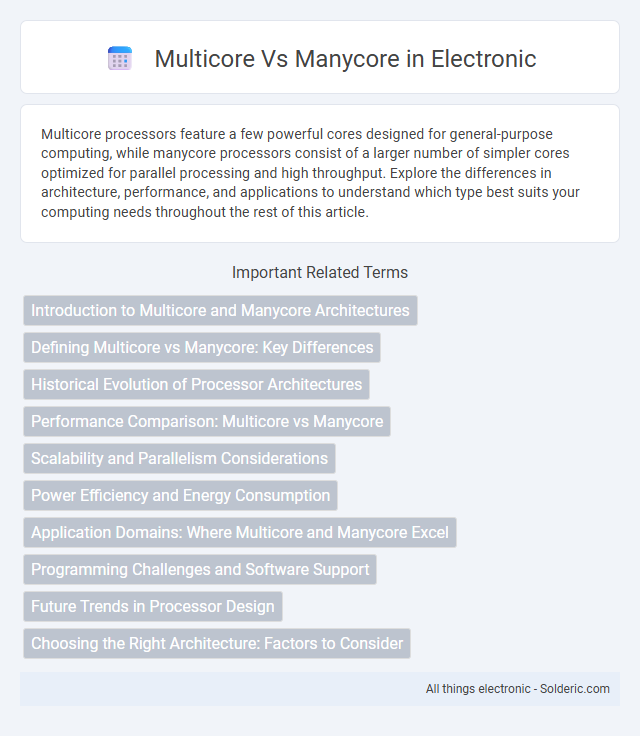Multicore processors feature a few powerful cores designed for general-purpose computing, while manycore processors consist of a larger number of simpler cores optimized for parallel processing and high throughput. Explore the differences in architecture, performance, and applications to understand which type best suits your computing needs throughout the rest of this article.
Comparison Table
| Aspect | Multicore | Manycore |
|---|---|---|
| Core Count | 2 to 16 cores | Hundreds to thousands of cores |
| Architecture | General-purpose cores | Simple, highly parallel cores |
| Use Case | Sequential and moderate parallel tasks | Highly parallel workloads like GPU tasks |
| Power Consumption | Higher per core | Lower per core, efficient at scale |
| Performance Focus | Single-thread and moderate parallel performance | Massive parallel throughput |
| Programming Model | Traditional multithreading | SIMD, data-parallel programming |
| Examples | Intel Core i7, AMD Ryzen | NVIDIA CUDA GPUs, Intel Xeon Phi |
Introduction to Multicore and Manycore Architectures
Multicore architectures integrate a limited number of powerful processor cores on a single chip, designed to efficiently handle diverse tasks and maximize performance per core. Manycore architectures, by contrast, feature dozens or even hundreds of simpler cores optimized for parallel processing and high throughput in data-intensive applications. Understanding these distinctions helps you choose the optimal architecture for workloads ranging from complex computations to large-scale simulations.
Defining Multicore vs Manycore: Key Differences
Multicore processors typically consist of a few powerful cores designed for parallel processing and balanced performance across diverse applications. Manycore processors feature dozens or even hundreds of simpler cores optimized for extreme parallelism and specialized workload efficiency. Your choice between multicore and manycore depends on the specific computing tasks and scalability requirements.
Historical Evolution of Processor Architectures
Multicore processors emerged from the limitations of increasing clock speeds, integrating two to eight cores on a single chip to enhance parallelism while maintaining power efficiency. Manycore architectures expanded this concept significantly, featuring dozens to hundreds of simpler cores designed for highly parallel workloads like scientific computing and AI processing. Understanding this historical evolution helps you appreciate how processor designs shifted from focusing on single-core performance to maximizing concurrency and energy efficiency.
Performance Comparison: Multicore vs Manycore
Multicore processors typically excel in handling a moderate number of complex, sequential tasks with high single-threaded performance, making them ideal for general-purpose computing and multi-threaded applications. Manycore architectures, featuring dozens to hundreds of smaller cores, deliver superior parallel processing capabilities for highly parallel workloads such as scientific simulations, machine learning, and graphics rendering. Performance benchmarks highlight multicore efficiency in workloads requiring strong per-core performance, while manycore systems offer greater throughput and energy efficiency in massively parallel tasks.
Scalability and Parallelism Considerations
Multicore processors, with a limited number of powerful cores, offer moderate scalability and handle parallel tasks effectively, but they may face bottlenecks as workloads increase. Manycore architectures, featuring dozens or hundreds of simpler cores, excel in massive parallelism and high scalability, making them ideal for highly parallel applications like scientific simulations or AI. Your choice between multicore and manycore depends on the required balance of single-thread performance and the ability to scale parallel workloads efficiently.
Power Efficiency and Energy Consumption
Multicore processors optimize power efficiency by balancing performance and energy consumption through fewer, more complex cores operating at higher frequencies. Manycore architectures achieve lower energy consumption by employing a larger number of simpler, smaller cores that run at lower frequencies, enabling better parallelism for power-sensitive applications. Understanding Your workload requirements helps determine the optimal balance between multicore and manycore designs to maximize power efficiency.
Application Domains: Where Multicore and Manycore Excel
Multicore processors excel in general-purpose computing tasks such as desktop applications, gaming, and complex simulations due to their balanced core count and high single-thread performance. Manycore processors are optimized for highly parallel workloads found in scientific computing, machine learning, and large-scale data analytics, leveraging hundreds or thousands of cores to maximize throughput. In autonomous systems and real-time processing, manycore architectures deliver superior efficiency by parallelizing sensor data analysis and decision-making algorithms.
Programming Challenges and Software Support
Multicore processors often benefit from mature programming tools and established parallel programming models like OpenMP and pthreads, making software support more accessible for developers. Manycore architectures, with tens or hundreds of cores, introduce significant programming challenges due to increased complexity in synchronization, memory coherence, and task scheduling, requiring advanced frameworks and fine-grained parallelism strategies. Your ability to leverage efficient parallel algorithms and concurrency primitives is critical in harnessing the full potential of manycore systems.
Future Trends in Processor Design
Future trends in processor design emphasize an increase in core counts, shifting from traditional multicore architectures, typically featuring up to dozens of cores, to manycore systems encompassing hundreds or thousands of cores. Manycore processors optimize parallelism and energy efficiency for tasks like artificial intelligence, machine learning, and high-performance computing, leveraging advanced interconnects and heterogeneous core designs. The ongoing evolution integrates specialized accelerators and chiplet technology to balance power, performance, and scalability in complex workloads.
Choosing the Right Architecture: Factors to Consider
When choosing between multicore and manycore architectures, consider factors like the nature of your workload, power efficiency, and parallel processing needs. Multicore processors excel at handling diverse and moderately parallel tasks, offering better single-thread performance, while manycore architectures are optimized for highly parallel, data-intensive applications such as AI or scientific simulations. Your choice depends on balancing performance requirements with energy consumption and software compatibility for optimal system efficiency.
multicore vs manycore Infographic

 solderic.com
solderic.com